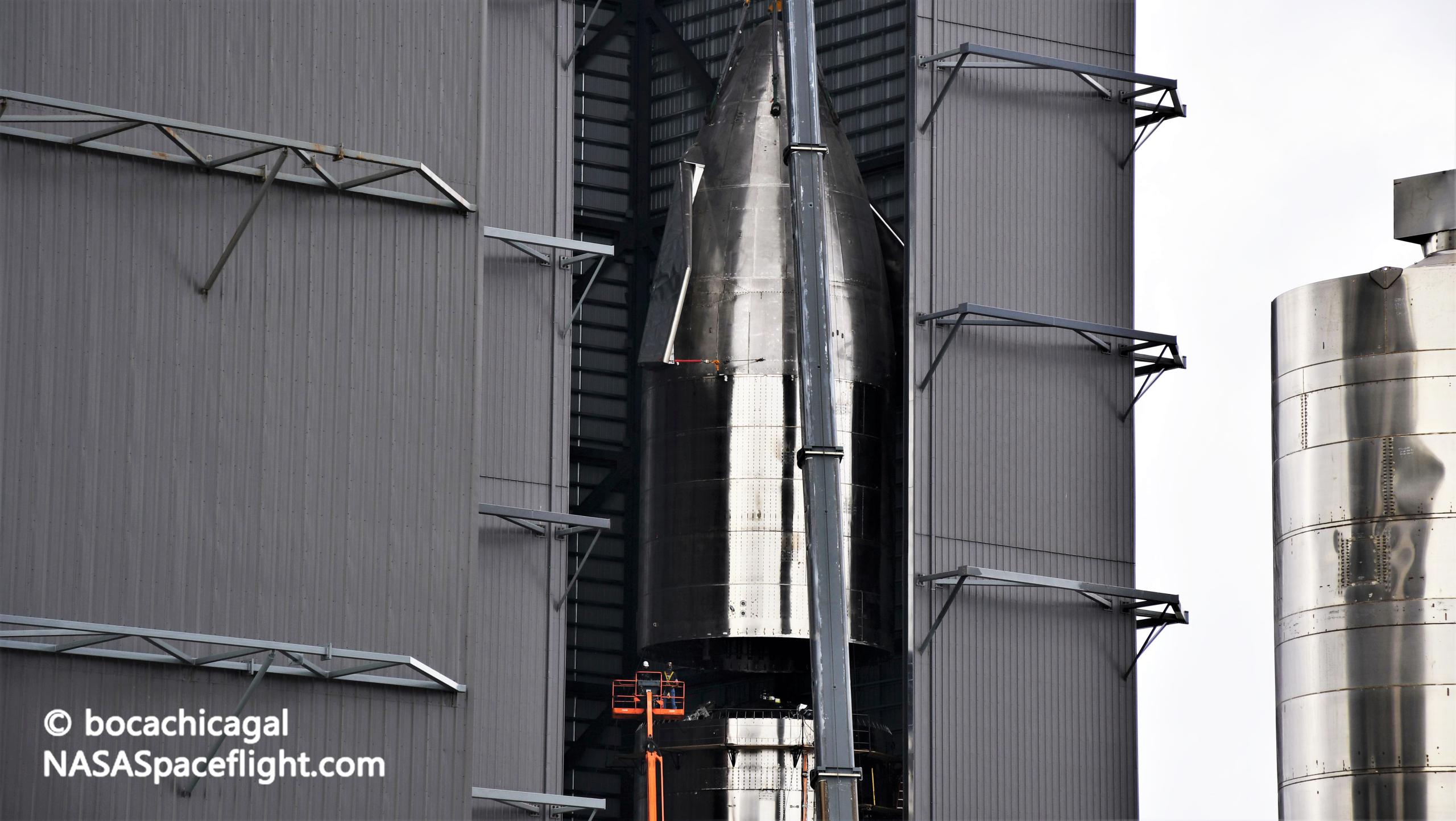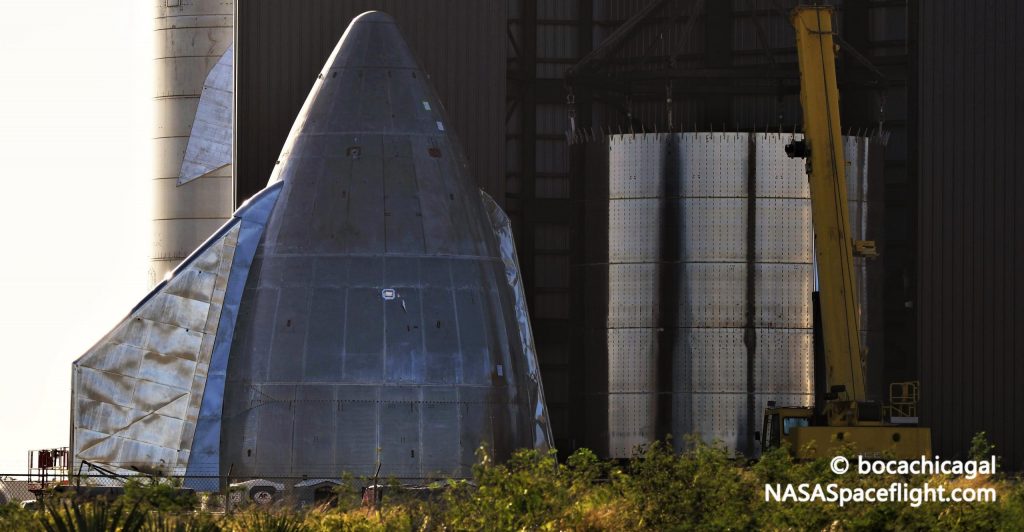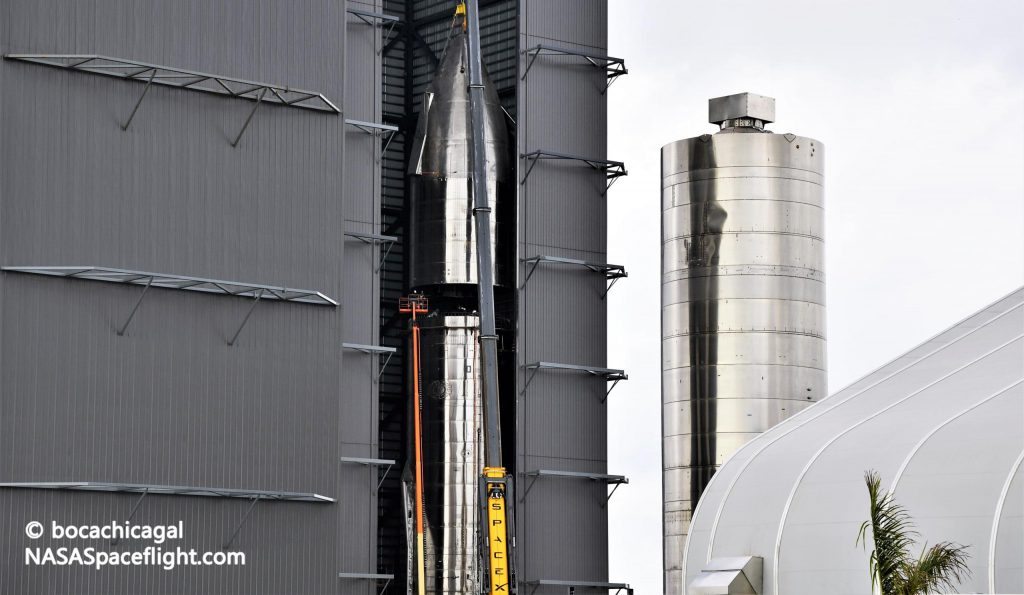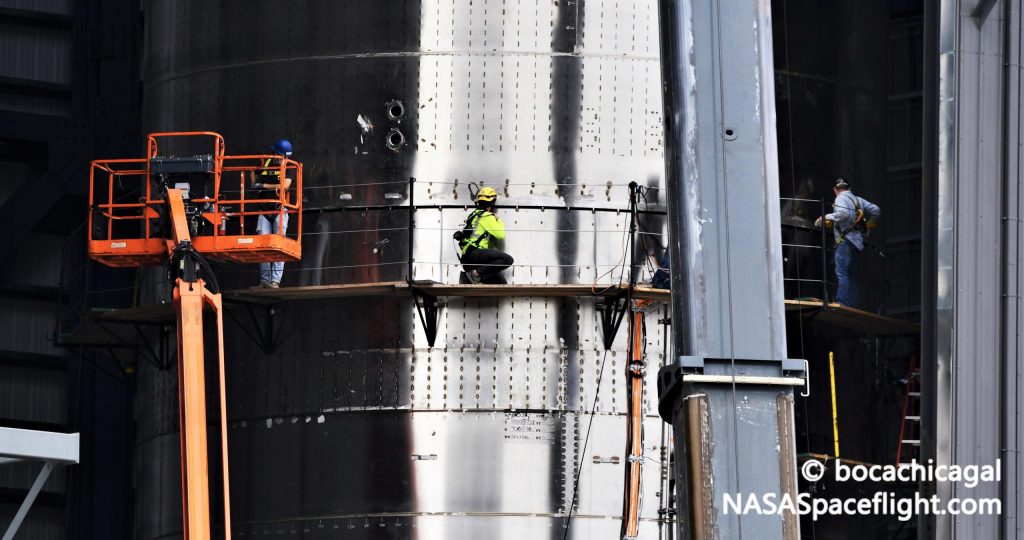

News
SpaceX backup Starship reaches full height after nosecone installation
SpaceX has installed another Starship’s nosecone, all but completing the second full-size prototype a matter of days before the first fully-assembled Starship’s risky launch debut.
Over the last two months, SpaceX has effectively put Starship number 8 (SN8) through an almost nonstop series of tests, completing at least four separate cryogenic proof tests, four Raptor engine static fires, and much more. The company’s South Texas team have also dodged an array of technical bugs; installed, plumbed, and wired what amounts to ~40% of Starship (the nose section) while fully exposed to the coastal elements; and even narrowly avoided a potentially catastrophic failure.
In spite of the many hurdles thrown up and delays resultant, CEO Elon Musk announced earlier this week that Starship SN8 is scheduled to attempt its 15-kilometer (~50,000 ft) launch debut as early as Monday, November 30th. Musk, however, does not see success as the most probable outcome.

Why, then, push to launch Starship SN8 when, in Musk’s own words, the probability of success is as low as “33%”? As previously discussed many times in the history of Teslarati’s BFR and Starship coverage, SpaceX’s attitude towards technology development is (unfortunately) relatively unique in the aerospace industry. While once a backbone of major parts of NASA’s Apollo Program moonshot, modern aerospace companies simply do not take risks, instead choosing a systems engineering methodology and waterfall-style development approach, attempting to understand and design out every single problem to ensure success on the first try.
The result: extremely predictable, conservative solutions that take huge sums of money and time to field but yield excellent reliability and all but guarantee moderate success. SpaceX, on the other hand, borrows from early US and German rocket groups and, more recently, software companies to end up with a development approach that prioritizes efficiency, speed, and extensive testing, forever pushing the envelope and thus continually improving whatever is built.
In the early stages of any program, the results of that approach can look extremely unusual and rudimentary without context (i.e. Starhopper, above), but building and testing a minimum viable product or prototype is a very intentional foundation. Particularly at the start, those minimal prototypes are extremely cheap and almost singularly focused on narrowing a vast range of design options to something more palatable. As those prototypes rapidly teach their builders what the right and wrong questions and design decisions are, more focused and refined prototypes are simultaneously built and tested.
Done well, the agile approach is often quite similar to evolution, where prototype failures inform necessary design changes and killing off dead-end strategies, designs, and assumptions before they can be built upon. In many cases, compared to cautious waterfall-style development, it will even produce results that are both better, cheaper, and faster to realize. SpaceX’s Starship program is perhaps the most visible example in history, made all the more interesting and controversial by the fact that it’s still somewhere in between its early, chaotic development phase and a clear path to a viable product.
On the build side of things, SpaceX has created a truly incredible ad hoc factory from next to nothing, succeeding to the point that the company is now arguably testing and pushing the envelope too slowly. As of November 2020, no fewer than eight full-size Starships and the first Super Heavy booster prototype are visibly under construction. Most recently, Starship SN9 was stacked to its full height, kicking off nosecone installation while still at the build site (unlike SN8). SN10’s completed tank section is likely ready to begin flap installation within the next few days, while Starship SN11 is perhaps a week or two behind that. Additionally, large tank sections of Starships SN12, SN13, SN14, SN15, and (most likely) SN16 are already completed and have all been spotted in the last few weeks.
Some ~90% of the above work was likely started after Starship SN8 first left the factory and rolled to the launch pad on September 26th. In many regards, SN8 has been the first to reach multiple major milestones, largely explaining the relatively plodding pace of its test program compared to SN4, SN5, and SN6.


Ultimately, SN9’s imminent completion – effectively a superior, more refined copy of SN8 – means that Starship SN8’s utility to SpaceX is rapidly deteriorating. The company would almost assuredly never skip an opportunity to learn, meaning that there’s no plausible future in which SN8 testing doesn’t continue, but that doesn’t mean that SpaceX can’t turn its risk tolerance to 11. In essence, accept a 67% (or higher) chance of Starship SN8’s violent destruction but learn as much as possible in the process. As long as good data is gathered, SN8’s launch debut will be a success for Starship whether the rocket lands in one or several pieces.
Elon Musk
Tesla reveals it is using AI to make factories more sustainable: here’s how
Tesla is using AI in its Gigafactory Nevada factory to improve HVAC efficiency.

Tesla has revealed in its Extended Impact Report for 2024 that it is using Artificial Intelligence (AI) to enable its factories to be more sustainable. One example it used was its achievement of managing “the majority of the HVAC infrastructure at Gigafactory Nevada is now AI-controlled” last year.
In a commitment to becoming more efficient and making its production as eco-friendly as possible, Tesla has been working for years to find solutions to reduce energy consumption in its factories.
For example, in 2023, Tesla implemented optimization controls in the plastics and paint shops located at Gigafactory Texas, which increased the efficiency of natural gas consumption. Tesla plans to phase out natural gas use across its factories eventually, but for now, it prioritizes work to reduce emissions from that energy source specifically.
It also uses Hygrometric Control Logic for Air Handling Units at Giafactory Berlin, resulting in 17,000 MWh in energy savings each year. At Gigafactory Nevada, Tesla saves 9.5 GWh of energy through the use of N-Methylpyrrolidone refineries when extracting critical raw material.
Perhaps the most interesting way Tesla is conserving energy is through the use of AI at Gigafactory Nevada, as it describes its use of AI to reduce energy demand:
“In 2023, AI Control for HVAC was expanded from Nevada and Texas to now include our Berlin-Brandenburg and Fremont factories. AI Control policy enables HVAC systems within each factory to work together to process sensor data, model factory dynamics, and apply control actions that safely minimize the energy required to support production. In 2024, this system achieved two milestones: the majority of HVAC infrastructure at Gigafactory Nevada is now AI-controlled, reducing fan and thermal energy demand; and the AI algorithm was extended to manage entire chiller plants, creating a closed-loop control system that optimizes both chilled water consumption and the energy required for its generation, all while maintaining factory conditions.”
Tesla utilizes AI Control “primarily on systems that heat or cool critical factory production spaces and equipment.” AI Control communicates with the preexisting standard control logic of each system, and any issues can be resolved by quickly reverting back to standard control. There were none in 2024.
Tesla says that it is utilizing AI to drive impact at its factories, and it has proven to be a valuable tool in reducing energy consumption at one of its facilities.
Elon Musk
Tesla analysts believe Musk and Trump feud will pass
Tesla CEO Elon Musk and U.S. President Donald Trump’s feud shall pass, several bulls say.

Tesla analysts are breaking down the current feud between CEO Elon Musk and U.S. President Donald Trump, as the two continue to disagree on the “Big Beautiful Bill” and its impact on the country’s national debt.
Musk, who headed the Department of Government Efficiency (DOGE) under the Trump Administration, left his post in May. Soon thereafter, he and President Trump entered a very public and verbal disagreement, where things turned sour. They reconciled to an extent, and things seemed to be in the past.
However, the second disagreement between the two started on Monday, as Musk continued to push back on the “Big Beautiful Bill” that the Trump administration is attempting to sign into law. It would, by Musk’s estimation, increase spending and reverse the work DOGE did to trim the deficit.
Every member of Congress who campaigned on reducing government spending and then immediately voted for the biggest debt increase in history should hang their head in shame!
And they will lose their primary next year if it is the last thing I do on this Earth.
— Elon Musk (@elonmusk) June 30, 2025
President Trump has hinted that DOGE could be “the monster” that “eats Elon,” threatening to end the subsidies that SpaceX and Tesla receive. Musk has not been opposed to ending government subsidies for companies, including his own, as long as they are all abolished.
How Tesla could benefit from the ‘Big Beautiful Bill’ that axes EV subsidies
Despite this contentious back-and-forth between the two, analysts are sharing their opinions now, and a few of the more bullish Tesla observers are convinced that this feud will pass, Trump and Musk will resolve their differences as they have before, and things will return to normal.
ARK Invest’s Cathie Wood said this morning that the feud between Musk and Trump is another example of “this too shall pass:”
BREAKING: CATHIE WOOD SAYS — ELON AND TRUMP FEUD “WILL PASS” 👀 $TSLA
She remains bullish ! pic.twitter.com/w5rW2gfCkx
— TheSonOfWalkley (@TheSonOfWalkley) July 1, 2025
Additionally, Wedbush’s Dan Ives, in a note to investors this morning, said that the situation “will settle:”
“We believe this situation will settle and at the end of the day Musk needs Trump and Trump needs Musk given the AI Arms Race going on between the US and China. The jabs between Musk and Trump will continue as the Budget rolls through Congress but Tesla investors want Musk to focus on driving Tesla and stop this political angle…which has turned into a life of its own in a roller coaster ride since the November elections.”
Tesla shares are down about 5 percent at 3:10 p.m. on the East Coast.
Elon Musk
Tesla scrambles after Musk sidekick exit, CEO takes over sales
Tesla CEO Elon Musk is reportedly overseeing sales in North America and Europe, Bloomberg reports.

Tesla scrambled its executives around following the exit of CEO Elon Musk’s sidekick last week, Omead Afshar. Afshar was relieved of his duties as Head of Sales for both North America and Europe.
Bloomberg is reporting that Musk is now overseeing both regions for sales, according to sources familiar with the matter. Afshar left the company last week, likely due to slow sales in both markets, ending a seven-year term with the electric automaker.
Tesla’s Omead Afshar, known as Elon Musk’s right-hand man, leaves company: reports
Afshar was promoted to the role late last year as Musk was becoming more involved in the road to the White House with President Donald Trump.
Afshar, whose LinkedIn account stated he was working within the “Office of the CEO,” was known as Musk’s right-hand man for years.
Additionally, Tom Zhu, currently the Senior Vice President of Automotive at Tesla, will oversee sales in Asia, according to the report.
It is a scramble by Tesla to get the company’s proven executives over the pain points the automaker has found halfway through the year. Sales are looking to be close to the 1.8 million vehicles the company delivered in both of the past two years.
Tesla is pivoting to pay more attention to the struggling automotive sales that it has felt over the past six months. Although it is still performing well and is the best-selling EV maker by a long way, it is struggling to find growth despite redesigning its vehicles and launching new tech and improvements within them.
The company is also looking to focus more on its deployment of autonomous tech, especially as it recently launched its Robotaxi platform in Austin just over a week ago.
However, while this is the long-term catalyst for Tesla, sales still need some work, and it appears the company’s strategy is to put its biggest guns on its biggest problems.
-

 Elon Musk1 day ago
Elon Musk1 day agoTesla investors will be shocked by Jim Cramer’s latest assessment
-

 News6 days ago
News6 days agoTesla Robotaxi’s biggest challenge seems to be this one thing
-

 News2 weeks ago
News2 weeks agoTesla’s Grok integration will be more realistic with this cool feature
-

 Elon Musk2 weeks ago
Elon Musk2 weeks agoElon Musk slams Bloomberg’s shocking xAI cash burn claims
-

 News2 weeks ago
News2 weeks agoTesla China roars back with highest vehicle registrations this Q2 so far
-

 News2 weeks ago
News2 weeks agoTexas lawmakers urge Tesla to delay Austin robotaxi launch to September
-

 News2 weeks ago
News2 weeks agoTesla dominates Cars.com’s Made in America Index with clean sweep
-

 Elon Musk1 week ago
Elon Musk1 week agoFirst Look at Tesla’s Robotaxi App: features, design, and more




















